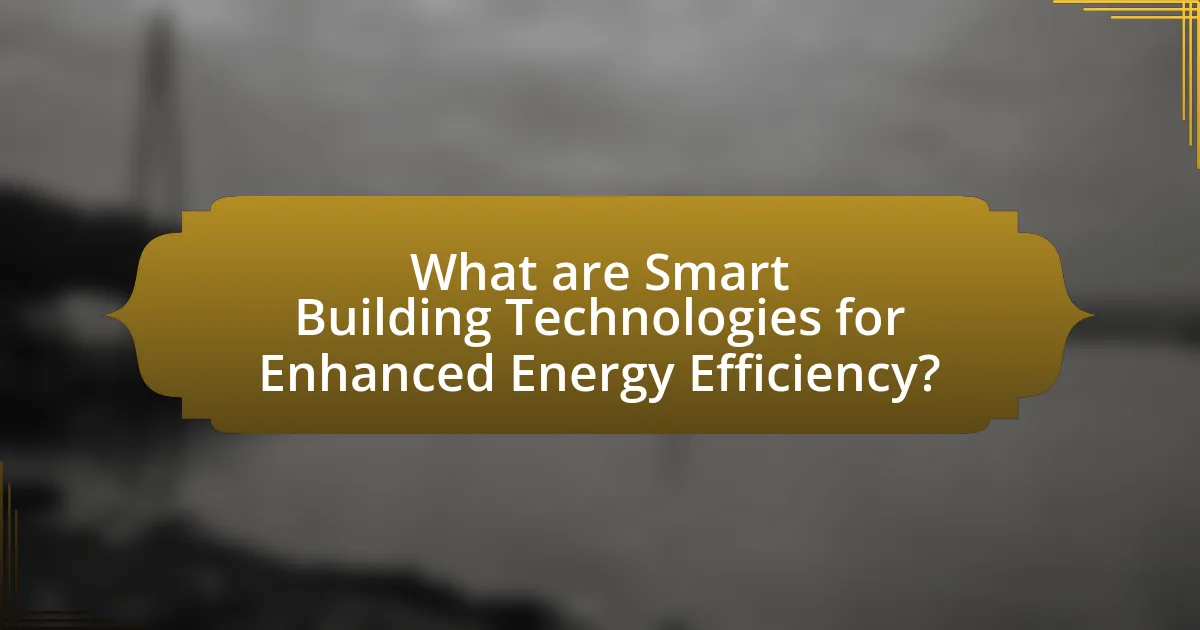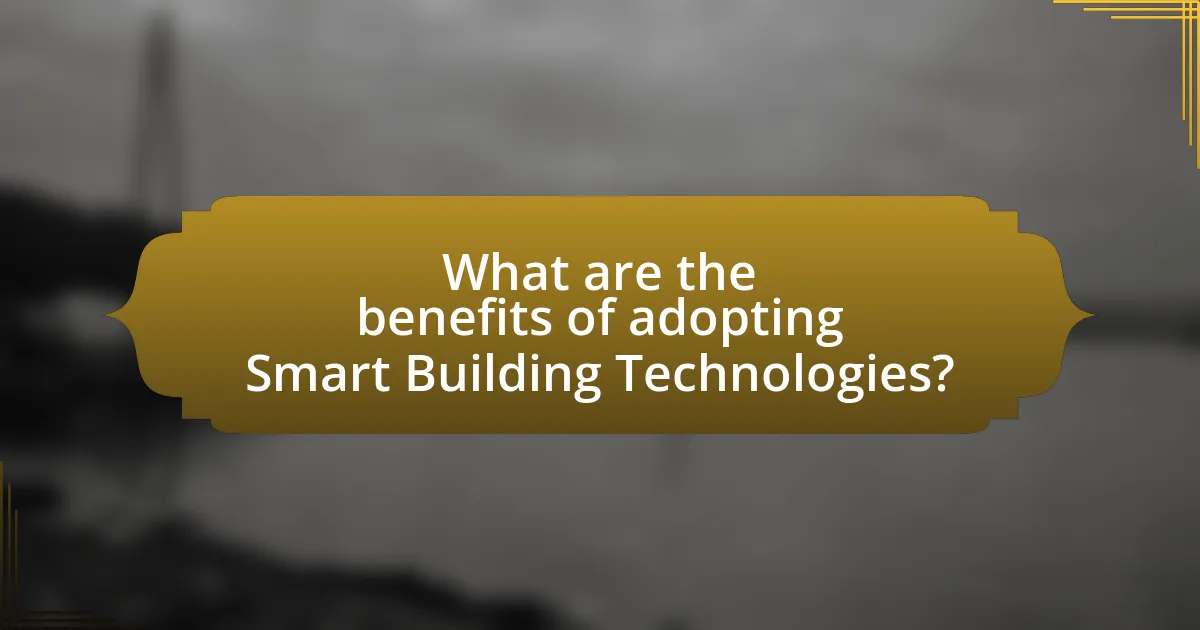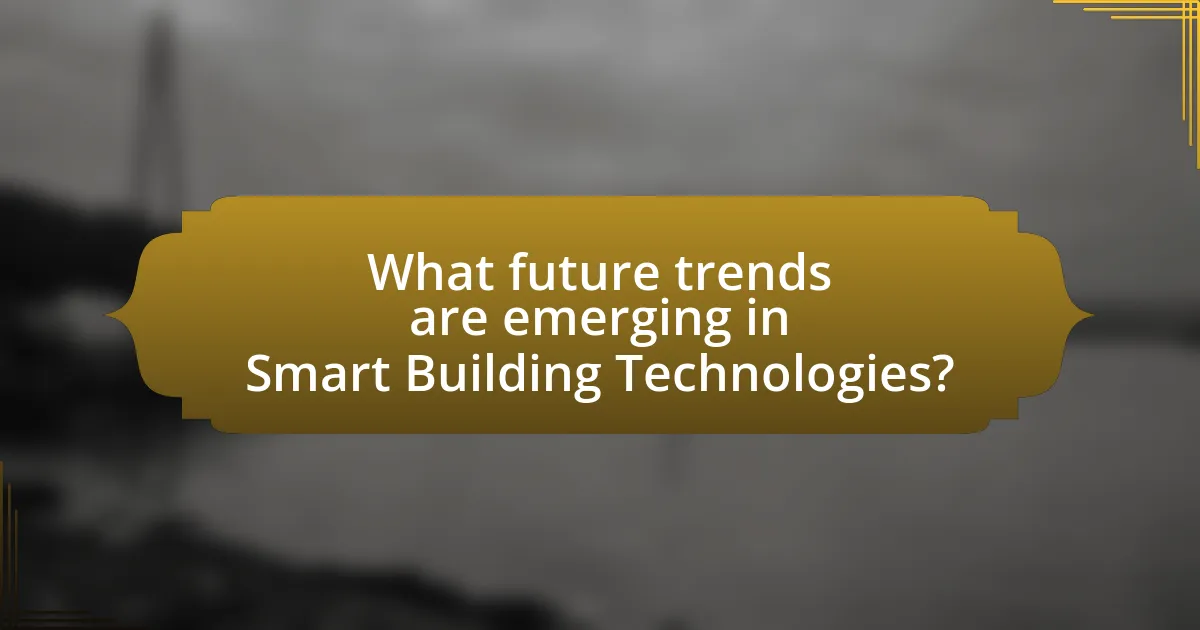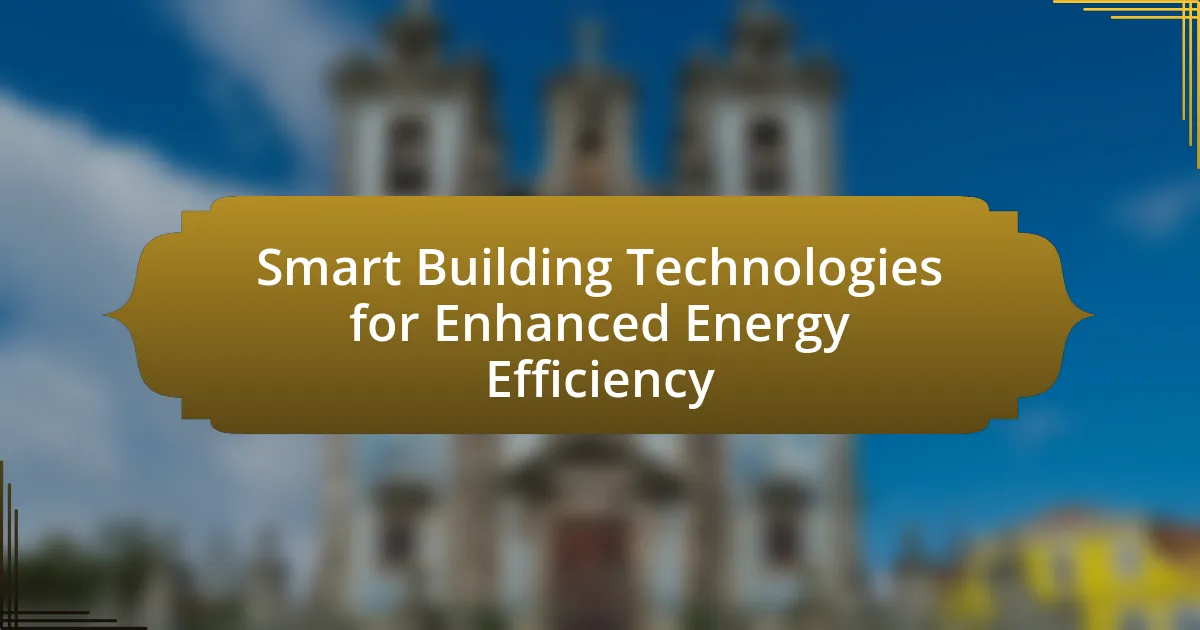Smart building technologies are advanced systems designed to enhance energy efficiency in buildings through the integration of smart lighting, HVAC controls, energy management systems, and IoT sensors. These technologies optimize energy consumption by utilizing real-time data to adjust usage based on occupancy and environmental conditions, resulting in significant energy savings of 10-30%. The article explores how these technologies contribute to operational efficiency, reduce carbon footprints, and improve occupant comfort, while also addressing the challenges of implementation and the importance of stakeholder engagement. Additionally, it highlights the role of renewable energy and predictive analytics in shaping the future of energy management in smart buildings.

What are Smart Building Technologies for Enhanced Energy Efficiency?
Smart building technologies for enhanced energy efficiency include systems such as smart lighting, advanced HVAC controls, energy management systems, and IoT sensors. These technologies optimize energy consumption by using real-time data to adjust energy use based on occupancy, weather conditions, and operational needs. For instance, smart lighting systems can automatically dim or turn off lights in unoccupied areas, leading to energy savings of up to 30%. Additionally, advanced HVAC systems can adjust heating and cooling based on occupancy patterns, resulting in significant reductions in energy costs. According to the U.S. Department of Energy, implementing smart building technologies can lead to energy savings of 10-30% in commercial buildings, demonstrating their effectiveness in enhancing energy efficiency.
How do Smart Building Technologies contribute to energy efficiency?
Smart Building Technologies enhance energy efficiency by utilizing advanced systems for monitoring, controlling, and optimizing energy use in buildings. These technologies, such as smart sensors, automated lighting, and HVAC systems, enable real-time data collection and analysis, allowing for precise adjustments based on occupancy and environmental conditions. For instance, a study by the U.S. Department of Energy found that smart building technologies can reduce energy consumption by up to 30% through improved operational efficiency and demand response strategies. This integration of technology not only lowers energy costs but also minimizes the carbon footprint of buildings, contributing to overall sustainability efforts.
What specific technologies are included in smart buildings?
Smart buildings incorporate various specific technologies, including Internet of Things (IoT) devices, building automation systems, energy management systems, smart lighting, HVAC control systems, and advanced security systems. These technologies work together to optimize energy efficiency, enhance occupant comfort, and improve overall building management. For instance, IoT devices enable real-time monitoring and control of building systems, while energy management systems analyze energy consumption patterns to identify savings opportunities.
How do these technologies interact to optimize energy use?
Smart building technologies optimize energy use through the integration of IoT devices, advanced analytics, and automation systems. These technologies work together by collecting real-time data on energy consumption, occupancy, and environmental conditions, allowing for dynamic adjustments to heating, cooling, and lighting systems. For instance, smart thermostats can learn user preferences and adjust settings accordingly, while occupancy sensors can turn off lights in unoccupied rooms, significantly reducing energy waste. Studies show that implementing these technologies can lead to energy savings of up to 30%, demonstrating their effectiveness in enhancing energy efficiency in buildings.
Why is energy efficiency important in modern buildings?
Energy efficiency is crucial in modern buildings because it significantly reduces energy consumption and operational costs. By implementing energy-efficient technologies, buildings can lower their carbon footprint, contributing to environmental sustainability. For instance, according to the U.S. Department of Energy, energy-efficient buildings can reduce energy use by 30% to 50% compared to traditional buildings. This reduction not only leads to cost savings for occupants but also enhances the overall comfort and health of the indoor environment.
What are the environmental impacts of energy inefficiency?
Energy inefficiency leads to increased greenhouse gas emissions, contributing to climate change and environmental degradation. When energy is wasted, more fossil fuels are burned to meet demand, resulting in higher carbon dioxide emissions. For instance, the U.S. Energy Information Administration reported that in 2020, energy-related carbon dioxide emissions were approximately 4.8 billion metric tons, largely driven by inefficient energy use in buildings and transportation. Additionally, energy inefficiency exacerbates air pollution, as burning fossil fuels releases harmful pollutants that can affect human health and ecosystems. The World Health Organization estimates that air pollution causes around 7 million premature deaths annually, highlighting the severe consequences of energy inefficiency on public health and the environment.
How does energy efficiency affect operational costs?
Energy efficiency significantly reduces operational costs by lowering energy consumption and minimizing utility expenses. For instance, implementing energy-efficient technologies, such as LED lighting and smart HVAC systems, can decrease energy usage by 20-50%, leading to substantial savings on electricity bills. According to the U.S. Department of Energy, buildings that adopt energy-efficient practices can save up to $1.4 billion annually in energy costs. This reduction in energy consumption not only lowers direct costs but also extends the lifespan of equipment, further decreasing maintenance and replacement expenses.
What are the key features of Smart Building Technologies?
Smart Building Technologies primarily feature automation, energy management, and connectivity. Automation allows for the control of lighting, heating, and cooling systems based on occupancy and usage patterns, enhancing comfort and reducing energy waste. Energy management systems monitor and optimize energy consumption in real-time, leading to significant cost savings and improved efficiency. Connectivity through the Internet of Things (IoT) enables devices to communicate and share data, facilitating better decision-making and predictive maintenance. These features collectively contribute to enhanced energy efficiency in smart buildings, as evidenced by studies showing that smart technologies can reduce energy consumption by up to 30%.
How do automation systems enhance energy management?
Automation systems enhance energy management by optimizing energy consumption through real-time monitoring and control of building systems. These systems utilize sensors and algorithms to analyze energy usage patterns, enabling adjustments that reduce waste and improve efficiency. For instance, a study by the U.S. Department of Energy found that buildings equipped with automation systems can achieve energy savings of 10-30% by adjusting lighting, heating, and cooling based on occupancy and environmental conditions. This data-driven approach not only lowers operational costs but also contributes to sustainability goals by minimizing carbon footprints.
What role do sensors and IoT play in energy efficiency?
Sensors and IoT play a critical role in enhancing energy efficiency by enabling real-time monitoring and control of energy consumption in buildings. These technologies collect data on various parameters such as temperature, occupancy, and energy usage, allowing for optimized energy management. For instance, a study by the U.S. Department of Energy found that smart sensors can reduce energy consumption by up to 30% in commercial buildings by adjusting heating, cooling, and lighting based on actual usage patterns. This data-driven approach not only minimizes waste but also supports predictive maintenance, further improving overall energy efficiency.
How can Smart Building Technologies be implemented effectively?
Smart Building Technologies can be implemented effectively by integrating advanced sensors, automation systems, and data analytics to optimize energy usage. These technologies enable real-time monitoring and control of building systems such as lighting, heating, and cooling, which can lead to significant energy savings. For instance, a study by the U.S. Department of Energy found that smart building technologies can reduce energy consumption by 20-50% when properly deployed. Additionally, utilizing Internet of Things (IoT) devices allows for seamless communication between systems, enhancing operational efficiency and occupant comfort.
What are the steps to integrate smart technologies into existing buildings?
To integrate smart technologies into existing buildings, the steps include assessing current infrastructure, selecting appropriate technologies, developing a comprehensive integration plan, implementing the technologies, and continuously monitoring and optimizing performance.
First, assessing the current infrastructure involves evaluating existing systems and identifying areas for improvement. Next, selecting appropriate technologies requires researching and choosing solutions that align with the building’s needs, such as smart lighting, HVAC systems, and energy management software.
Developing a comprehensive integration plan entails outlining the timeline, budget, and resources needed for implementation. Following this, implementing the technologies involves installing and configuring the selected systems while ensuring compatibility with existing infrastructure. Finally, continuously monitoring and optimizing performance is crucial for maximizing energy efficiency and ensuring that the smart technologies function as intended.
These steps are supported by industry practices that emphasize the importance of a structured approach to technology integration, which can lead to significant energy savings and improved operational efficiency in buildings.
How can building owners assess their energy efficiency needs?
Building owners can assess their energy efficiency needs by conducting an energy audit, which evaluates current energy consumption and identifies areas for improvement. This process typically involves analyzing utility bills, inspecting building systems such as HVAC and lighting, and using diagnostic tools to measure energy use. According to the U.S. Department of Energy, energy audits can lead to energy savings of 5% to 30% by pinpointing inefficiencies and recommending upgrades or behavioral changes.

What are the benefits of adopting Smart Building Technologies?
Adopting Smart Building Technologies significantly enhances energy efficiency by optimizing resource usage and reducing operational costs. These technologies utilize sensors, automation, and data analytics to monitor and control building systems such as lighting, heating, and cooling. For instance, a study by the U.S. Department of Energy found that smart building systems can reduce energy consumption by up to 30%. Additionally, smart buildings improve occupant comfort and productivity through better environmental control, which can lead to increased employee satisfaction and retention.
How do these technologies improve occupant comfort?
Smart building technologies improve occupant comfort by optimizing environmental conditions such as temperature, lighting, and air quality. These technologies utilize sensors and automation to adjust settings in real-time based on occupancy and preferences, ensuring a more personalized and comfortable experience. For instance, smart thermostats can learn individual temperature preferences and adjust heating or cooling accordingly, leading to a more pleasant indoor climate. Additionally, advanced lighting systems can mimic natural light patterns, enhancing mood and productivity. Studies have shown that improved air quality and thermal comfort can lead to increased occupant satisfaction and well-being, as evidenced by research from the Lawrence Berkeley National Laboratory, which found that better indoor environmental quality significantly correlates with occupant comfort levels.
What features enhance indoor air quality and lighting?
Features that enhance indoor air quality and lighting include advanced HVAC systems, air purifiers, smart lighting controls, and natural light integration. Advanced HVAC systems improve air circulation and filtration, reducing pollutants and allergens, while air purifiers remove harmful particles from the air. Smart lighting controls allow for adaptive lighting based on occupancy and natural light levels, optimizing energy use and enhancing comfort. Natural light integration, through windows and skylights, not only reduces reliance on artificial lighting but also positively impacts mood and productivity. Studies show that improved indoor air quality can lead to a 20% increase in productivity, highlighting the importance of these features in smart building technologies.
How does occupant feedback influence energy management?
Occupant feedback significantly influences energy management by providing insights into user preferences and behaviors, which can lead to optimized energy usage. When occupants share their experiences regarding temperature, lighting, and overall comfort, building management systems can adjust settings in real-time to enhance efficiency. For instance, a study by the Lawrence Berkeley National Laboratory found that incorporating occupant feedback into HVAC systems can reduce energy consumption by up to 30% while improving occupant satisfaction. This direct correlation between feedback and energy management demonstrates how engaging occupants can lead to more effective energy strategies in smart buildings.
What financial incentives exist for implementing Smart Building Technologies?
Financial incentives for implementing Smart Building Technologies include tax credits, rebates, and grants aimed at promoting energy efficiency. For instance, the U.S. federal government offers the Energy Efficient Commercial Buildings Deduction (Section 179D), which allows building owners to deduct up to $1.80 per square foot for energy-efficient improvements. Additionally, many utility companies provide rebates for the installation of smart technologies that reduce energy consumption, such as smart thermostats and lighting systems. According to the American Council for an Energy-Efficient Economy, these financial incentives can significantly lower the upfront costs associated with smart building upgrades, making them more accessible for property owners and developers.
What government programs support energy-efficient building upgrades?
The federal government supports energy-efficient building upgrades through programs such as the Energy Efficiency and Conservation Block Grant Program, which provides funding to local governments for energy-saving projects. Additionally, the Weatherization Assistance Program offers financial assistance to low-income households for energy efficiency improvements. The Federal Housing Administration also promotes energy-efficient mortgages, allowing borrowers to finance energy upgrades as part of their home loans. These programs collectively aim to reduce energy consumption and promote sustainable building practices, contributing to national energy efficiency goals.
How can businesses benefit from tax credits and rebates?
Businesses can benefit from tax credits and rebates by reducing their overall tax liability and improving cash flow. These financial incentives encourage investments in energy-efficient technologies, such as smart building systems, which can lead to significant cost savings on energy bills. For instance, the U.S. federal government offers the Energy Efficient Commercial Buildings Deduction, allowing businesses to deduct up to $1.80 per square foot for energy-efficient improvements. This not only lowers operational costs but also enhances the building’s value and sustainability profile, making it more attractive to tenants and investors.
What challenges do organizations face when adopting these technologies?
Organizations face several challenges when adopting smart building technologies for enhanced energy efficiency, including high initial costs, integration complexities, and a lack of skilled personnel. High initial costs can deter investment, as organizations must allocate significant budgets for technology acquisition and installation. Integration complexities arise from the need to connect new technologies with existing systems, which can lead to operational disruptions if not managed properly. Additionally, the lack of skilled personnel to implement and maintain these technologies can hinder effective adoption, as organizations may struggle to find qualified staff or require extensive training for current employees. These challenges can impede the successful implementation of smart building technologies, ultimately affecting energy efficiency outcomes.
How can resistance to change be addressed?
Resistance to change can be addressed by implementing effective communication strategies and involving stakeholders in the change process. Engaging employees through transparent discussions about the benefits of smart building technologies for enhanced energy efficiency fosters understanding and reduces apprehension. Research indicates that organizations that actively involve employees in decision-making processes experience a 70% higher success rate in change initiatives. Additionally, providing training and support helps individuals adapt to new technologies, further mitigating resistance.
What are the common technical hurdles in implementation?
Common technical hurdles in the implementation of smart building technologies for enhanced energy efficiency include interoperability issues, data integration challenges, and cybersecurity concerns. Interoperability issues arise when different systems and devices from various manufacturers cannot communicate effectively, leading to inefficiencies. Data integration challenges occur when aggregating data from multiple sources, making it difficult to analyze and utilize information for energy management. Cybersecurity concerns are significant as the increased connectivity of smart devices exposes buildings to potential cyber threats, necessitating robust security measures to protect sensitive data and systems.

What future trends are emerging in Smart Building Technologies?
Future trends in Smart Building Technologies include increased integration of artificial intelligence, enhanced energy management systems, and the adoption of Internet of Things (IoT) devices. Artificial intelligence is being utilized to optimize building operations, predict maintenance needs, and improve occupant comfort. Enhanced energy management systems are focusing on real-time data analytics to reduce energy consumption and costs, with studies indicating that smart buildings can achieve energy savings of up to 30%. The adoption of IoT devices enables seamless communication between systems, allowing for automated adjustments based on occupancy and environmental conditions, further contributing to energy efficiency.
How is artificial intelligence shaping energy management in buildings?
Artificial intelligence is transforming energy management in buildings by optimizing energy consumption and enhancing operational efficiency. AI algorithms analyze real-time data from various building systems, such as HVAC, lighting, and occupancy sensors, to predict energy usage patterns and adjust settings accordingly. For instance, a study by the Lawrence Berkeley National Laboratory found that AI-driven systems can reduce energy consumption by up to 30% through predictive maintenance and automated adjustments based on occupancy and weather conditions. This data-driven approach not only lowers energy costs but also contributes to sustainability goals by minimizing carbon footprints in urban environments.
What predictive analytics tools are becoming popular?
Predictive analytics tools that are becoming popular include Microsoft Azure Machine Learning, IBM Watson Studio, and Google Cloud AI Platform. These tools are increasingly utilized in smart building technologies to enhance energy efficiency by analyzing data patterns and predicting energy consumption trends. For instance, Microsoft Azure Machine Learning offers robust algorithms that can optimize energy usage based on historical data, while IBM Watson Studio provides advanced analytics capabilities that help in forecasting energy needs. Google Cloud AI Platform integrates machine learning models that assist in real-time energy management, making these tools essential for modern energy-efficient building solutions.
How can machine learning optimize energy consumption patterns?
Machine learning can optimize energy consumption patterns by analyzing large datasets to identify usage trends and predict future energy needs. By employing algorithms that learn from historical consumption data, machine learning models can provide insights into peak usage times, enabling more efficient energy distribution. For instance, a study by the Lawrence Berkeley National Laboratory found that machine learning applications in smart buildings can reduce energy consumption by up to 20% through predictive analytics and automated control systems. This demonstrates that machine learning not only enhances operational efficiency but also contributes to significant energy savings.
What role does renewable energy play in smart buildings?
Renewable energy plays a crucial role in smart buildings by providing a sustainable and efficient power source that reduces reliance on fossil fuels. Smart buildings integrate renewable energy technologies, such as solar panels and wind turbines, to generate clean energy on-site, which enhances energy efficiency and lowers operational costs. According to the U.S. Department of Energy, buildings that utilize renewable energy can achieve significant reductions in greenhouse gas emissions, contributing to environmental sustainability. Additionally, the integration of energy management systems in smart buildings allows for real-time monitoring and optimization of energy use, further maximizing the benefits of renewable energy sources.
How can solar energy systems be integrated into smart buildings?
Solar energy systems can be integrated into smart buildings through the use of photovoltaic panels, energy management systems, and smart grid technology. Photovoltaic panels can be installed on rooftops or facades to convert sunlight into electricity, which can then be used to power building systems or stored in batteries for later use. Energy management systems optimize energy consumption by analyzing data from various sources, allowing for real-time adjustments to maximize efficiency. Additionally, smart grid technology facilitates communication between the building and the energy provider, enabling demand response strategies that further enhance energy efficiency. According to the U.S. Department of Energy, buildings equipped with solar energy systems can reduce energy costs by up to 50%, demonstrating the effectiveness of this integration.
What are the benefits of energy storage solutions in smart buildings?
Energy storage solutions in smart buildings provide several key benefits, including enhanced energy efficiency, cost savings, and improved grid resilience. These systems allow buildings to store excess energy generated from renewable sources, such as solar panels, for later use, thereby reducing reliance on the grid during peak demand times. According to the U.S. Department of Energy, energy storage can lower energy costs by enabling demand response strategies, which shift energy usage to off-peak hours when electricity prices are lower. Additionally, energy storage enhances the reliability of power supply, as it can provide backup during outages, contributing to overall grid stability.
What best practices should be followed for successful implementation?
Successful implementation of smart building technologies for enhanced energy efficiency requires a structured approach that includes stakeholder engagement, thorough planning, and continuous monitoring. Engaging stakeholders ensures that all relevant parties, including building owners, occupants, and technology providers, are aligned on goals and expectations, which is crucial for buy-in and support. Thorough planning involves conducting a comprehensive energy audit to identify specific needs and opportunities for improvement, as well as establishing clear objectives and timelines for implementation. Continuous monitoring is essential to assess performance against energy efficiency targets, allowing for adjustments and optimizations based on real-time data. According to a study by the U.S. Department of Energy, buildings that implement these best practices can achieve energy savings of 20-50%, demonstrating the effectiveness of a strategic approach to smart building technologies.
How can organizations ensure ongoing maintenance and updates of smart systems?
Organizations can ensure ongoing maintenance and updates of smart systems by implementing a structured maintenance plan that includes regular software updates, hardware checks, and performance assessments. This approach allows organizations to proactively address potential issues, ensuring that smart systems operate efficiently and effectively. For instance, a study by the National Institute of Standards and Technology highlights that regular updates can reduce system vulnerabilities by up to 80%, thereby enhancing overall security and functionality. Additionally, establishing a dedicated team for monitoring and managing these systems can facilitate timely interventions and adaptations to evolving technologies, ensuring that smart systems remain current and effective in enhancing energy efficiency.
What strategies can be employed to engage stakeholders in the process?
To engage stakeholders in the process of implementing smart building technologies for enhanced energy efficiency, organizations can employ strategies such as regular communication, collaborative decision-making, and educational workshops. Regular communication ensures stakeholders are informed about project developments and can provide feedback, fostering a sense of ownership. Collaborative decision-making involves stakeholders in the planning and execution phases, which increases their investment in the outcomes. Educational workshops can enhance understanding of smart technologies and their benefits, leading to more informed stakeholder participation. These strategies are supported by research indicating that stakeholder engagement significantly improves project success rates and satisfaction levels, as evidenced by a study published in the Journal of Cleaner Production, which found that inclusive practices lead to better energy efficiency outcomes in building projects.

Leave a Reply